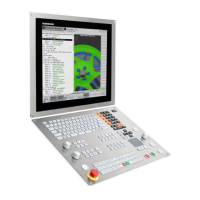17
With TCPM you can define the behavior of
the tilting and compensating movements
automatically calculated by the TNC 640.
TCPM defines the interpolation between
the start and end positions:
• During face milling—machining mainly
with the face of the tool—the tool point
moves on a straight line. The path of the
tool’s cylindrical surface is not defined,
but rather it depends on the machine
geometry.
• During peripheral milling, machining is
mainly by the side of the tool. The tool tip
also travels on a straight path, but
additionally the tool’s circumference
machines an explicitly defined plane.
TCPM defines the effect of the pro-
grammed feed rate as desired either
• as the actual velocity of the tool tip
relative to the workpiece. Very high
axis feed rates can result from large
compensating motions during machining
near the center of tilting.
• as contouring feed rate of the axes
programmed in the NC block. The feed
rate is usually lower, but you attain better
surface quality during large compen-
sating movements.
With TCPM you can also define the effect
of the inclination angle for more uniform
cutting passes when working with an
inclined radius cutter:
• Angle of inclination defined as axis angle
• Angle of inclination defined as spatial
angle
The TNC takes the inclination angle into
account in all 3-D machining—even with
45° swivel heads or tilting tables. You either
specify the angle of inclination in the NC
program via a miscellaneous function, or
adjust it manually with an electronic
handwheel. The TNC 640 makes sure that
the tool remains on the contour and does
not damage the workpiece.

